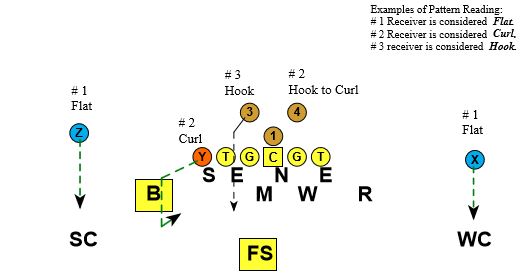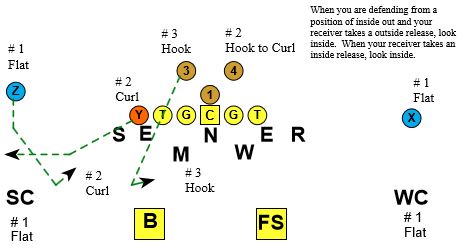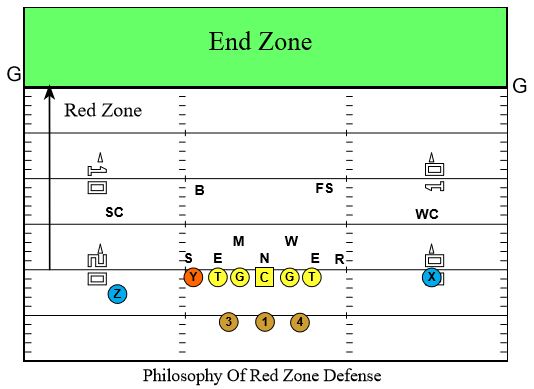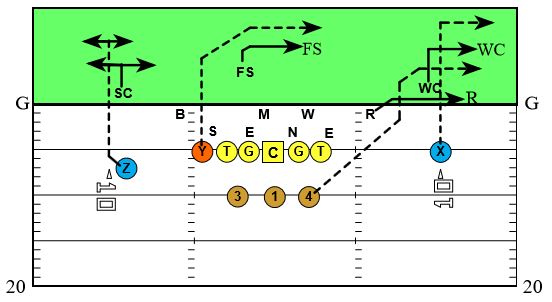This post is the second part of this article.
To read part 1, click here: Drop Zones and Coverage Part 1
Pass Zone Concept: Pattern Read
Numbering Receivers In Your Zone: When we talk about zone coverage and the concept of playing the man in your zone, you must first be aware of who can become a potential threat in your zone. Your defenders must first begin by numbering their eligible receivers from the outside in, and by naming the receivers in accordance with the pass zones they can initially threaten.

When the ball is snapped and the play develops, receivers will run combination routes, some of which will cross. When receivers run routes which cross, they exchange numbers and pass zones. When receivers run crossing routes or exchanges our defenders must adjust to the receivers now in their pass zones.

Remember: If you have Flat then stay as wide as the widest receiver. If you have curl make the quarterback throw across your face. If you have Hook, stay inside the same as you would if you had Curl.
Red Zone Technique / Minus 20 and In
Red Zone is that area on the -20 and In. Red Zone puts the defense with their backs to the wall. An offensive goal that most teams have is to score everytime inside the Red Zone. Once our opponent has moved into the Red Zone territory, we now must change, or better yet slow down our drops in zone or man technique.

Philosophy of Red Zone technique is to never beat a receiver to the end zone. If a receiver catches a pass in front of you in the end zone, it is a touchdown no matter how hard you hit him. We want the ball to be thrown over the secondary defenders, or thrown like a bullet between the defender and receiver if we are in zone coverage. If the offense has to throw a bullet, it had better be right on target or it’s intercepted. No matter what coverage you are in, this philosophy applies “Keep the Receiver Behind You”.
Remember, the width of the field never changes, but the distance to the goal line is constantly changing. The closer the offense gets to the goal line, the vertical field shrinks. The offensive philosophy must change to utilize the space available. The offense must either throw (quick fades, slants, outs) or they must utilize the width of the field with picks and crossing routes.
We must always be aware of the position of the ball to properly defend the field. The width will never change so you must always defend the entire width, but the vertical stretch to the goal line will change so you must defend the area of the field between the line of scrimmage and receivers.

When playing red zone technique you can use your normal technique according to the coverage called, except you might consider slowing down your back pedals or drops to stay underneath the receivers. The closer the ball gets to the goal line, the slower will will back pedal or drop. Once the receiver we are defending crosses the goal line we should be between him and the ball at all times. Never beat the receiver into the end zone, this rule pertains to every coverage, zone or man. Don’t get behind the receiver or its a touchdown. If you are playing man then you want to be between the receiver and the ball.
The only time you get deeper than the receiver in the end zone is when you get high-lowed by multiple receivers in our zone coverage. If we get a receiver in front of us and in back of us we will split the two receivers favoring the front receiver in order to break on the ball and stop the touchdown. Let the back end of the end zone help you defend the deeper receiver and play the fade pass agressively, the quarterback must lob the ball over your head but in front of the back of the end zone.
An important point to remember with RED ZONE TECHNIQUE if you play behind the receiver in this territory it probably will result in a “Touchdown” so, stay in front of the receivers.
About the Author of this post:
Jerry Campbell has over 30 years of high school and college coaching experience. He has experience as a head coach, offensive coordinator, and various position coaches. He has written numerous football coaching articles in various publications, is the author of over 30 books on coaching football, and has produced 12 coaching video series. Additionally, he is a nationally sought after speaker on the coaching clinic circuit.